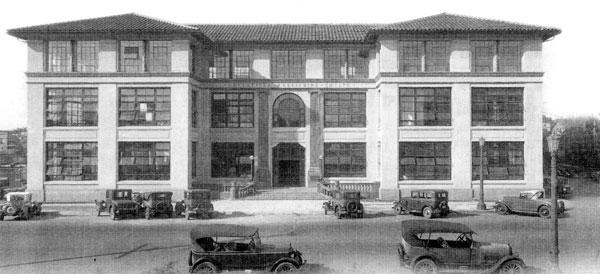605 Kapiolani Blvd, Honolulu, HI 96813
Designed By
Walter Emory and Marshall Webb
Highlights of Hawaii’s Daily Newspapers and Their Locations
by Lowell Angell
Since Hawaii’s first newspaper, Ka Lama Hawaii, was published in 1834 at Lahaina, Maui, it’s estimated that there have been more than 1,000 different news publications, varying in frequency and in at least nine languages.
The two best known today are, of course, The Honolulu Advertiser and Honolulu Star-Bulletin.
The Pacific Commercial Advertiser began as a weekly on July 2, 1856, and is Hawaii’s oldest continuously published newspaper. Founded by businessman and missionary son Henry M. Whitney, the paper was pro-American and pro-annexation, except when Walter Murray Gibson, a royalist and front for Claus Spreckles, ran it from 1880-1887. It was later purchased by annexationist Lorrin A. Thurston, former cabinet minister under King Kalākaua. Wallace Rider Farrington (Territorial Governor, 1921-1929) was editor from 1894-1897. The paper became The Honolulu Advertiser on March 31, 1921.
Although not its first home, the Advertiser was located in the W.W. Dimond building on King Street, between Fort and Bethel Streets, until 1913. [W.W. Dimond & Co. sold home furnishings. In 1936, the King Theatre was built on the site, now a multi-story parking garage]. The Advertiser then moved to King Street, between Richards and Alakea Streets. The building, later extended to Merchant Street, still exists as the Arcade Building.
In January 1930, the Advertiser occupied its present home at 605 Kapi‘olani Boulevard at South Street. Designed by architects Walter Emory and Marshall Webb, the three-story Beaux Arts building features large divided-lite awning windows and a Spanish tile hipped roof. The third floor once housed Hawaii’s oldest radio station, KGU, then partially owned by the Advertiser and broadcasting since 1922; its twin roof towers were a downtown landmark. The lobby had terra cotta detailing throughout, with hand-painted ceramic tile and stenciling on the walls and ceiling, much of it still extant. In the center was a lush open garden courtyard. Floored over in 1961 to provide more space, the area enjoyed another life as a popular community art gallery, and forerunner of today’s Contemporary Museum. From 1962-2001, the building housed both daily newspapers, under a joint operating agreement. The structure is listed on the State and National Registers of Historic Places.
The Honolulu Star-Bulletin traces its roots to two papers. The Hawaiian Star, begun March 28, 1893, was strongly pro-American; the “Star” in its name represented the U.S. flag. The Evening Bulletin dates to 1871 and was published daily from 1882. W.R. Farrington came from the Advertiser as editor in June 1898, until 1912, then was president and publisher until his death in 1933. Always a strong advocate for annexation, as early as 1900 Farrington had urged that the Islands join the Union. On July 1, 1912 the papers merged to become the Honolulu Star-Bulletin.
The Star-Bulletin’s earliest extant home, at 125 Merchant Street, dates from 1902, a simple two-story building designed by Clinton B. Ripley and Louis Davis for the Hawaiian Star. A later extension to Queen Street housed the presses. Those were moved in the 1950s to a building at Hotel Street and Kapi‘olani Boulevard, an area acquired in the mid-1970s by the City as part of Mayor Fasi’s civic center master plan. It is now a large lawn and site of the Fasi Municipal Building and adjacent parking structure.
The Merchant Street building has been much altered as retail and office space; likewise the addition on Queen Street. However, it was added to the Hawai‘i State Register of Historic Places earlier this year in recognition of its historic significance.
Sources: Much of this information is from two excellent books on Hawaii’s fascinating newspaper history, Helen G. Chapin’s Shaping History: The Role of Newspapers in Hawaii and George Chaplin’s Presstime in Paradise: The Life and Times of the Honolulu Advertiser, 1856-1995; as well as newspaper articles by Burl Burlingame and Helen Altonn.
UPDATE (2012) – CONTINUED THREAT
Several generations’ worth of ink-stained wretches could have worked at 605 Kapi’olani Blvd., a circa-1930 Beaux Arts beauty we featured in 2009. Home to The Honolulu Advertiser newspaper, as well as The Honolulu Star-Bulletin during their joint-operating-agreement years, the building and 3.7 acre property around it has had an unclear future for some time. It was put up for sale by Gannet Pacific Corp. in 2005, but an agreement for its purchase wasn’t made until 2010. That fell through, and the plot twists continued when Hawai’i Five-O came in to lease it for its soundstage and production purposes. In August, it was announced that the local housing developer, Marshall Hung, and investment group, Tradewind Capital Group Inc., intend to purchase the property with a plan for 1,000 housing units.


